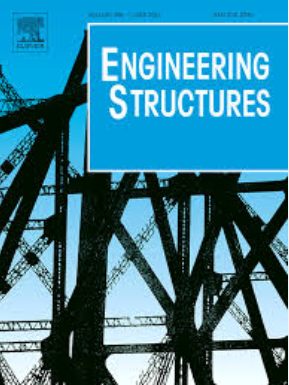Finite element analysis and design of triple grades hybrid high-performance steel structure (TGHSS)
IF 5.6
1区 工程技术
Q1 ENGINEERING, CIVIL
引用次数: 0
Abstract
The triple grades hybrid high-performance steel structure (TGHSS) is an innovative structural system comprising ordinary strength steel beams, high strength steel (HSS) columns, and low yield point (LYP) steel buckling-restrained braces (BRBs). Previous experimental and numerical studies have revealed the excellent seismic behaviour of TGHSSs. In this study, nonlinear analyses were conducted to investigate the structural performance of TGHSSs, including their load-bearing and deformation capacities, capacity reserves, plastic development, and dynamic responses. A conventional buckling-restrained braced frame (CBRBF) with all components based on ordinary strength steel was designed for comparison. Generally, TGHSSs have 8.4 %–12 % higher load-bearing capacity, 34 %–35 % higher deformation capacity, 11 % increased ductility reserve, and 71 % increased resistance reserve. Likewise, TGHSSs feature a smaller response modification factor R, indicating a larger design base shear. Through strategic balancing of steel grades in different components, TGHSSs can achieve improved seismic behaviours, including enhanced structural capacity, relieved plastic development, and suppressed dynamic responses. An effective performance-based design method is proposed with recommended performance factor Ω and material overstrength factor ηy to achieve capacity design among components.
求助全文
约1分钟内获得全文
求助全文
来源期刊

Engineering Structures
工程技术-工程:土木
CiteScore
10.20
自引率
14.50%
发文量
1385
审稿时长
67 days
期刊介绍:
Engineering Structures provides a forum for a broad blend of scientific and technical papers to reflect the evolving needs of the structural engineering and structural mechanics communities. Particularly welcome are contributions dealing with applications of structural engineering and mechanics principles in all areas of technology. The journal aspires to a broad and integrated coverage of the effects of dynamic loadings and of the modelling techniques whereby the structural response to these loadings may be computed.
The scope of Engineering Structures encompasses, but is not restricted to, the following areas: infrastructure engineering; earthquake engineering; structure-fluid-soil interaction; wind engineering; fire engineering; blast engineering; structural reliability/stability; life assessment/integrity; structural health monitoring; multi-hazard engineering; structural dynamics; optimization; expert systems; experimental modelling; performance-based design; multiscale analysis; value engineering.
Topics of interest include: tall buildings; innovative structures; environmentally responsive structures; bridges; stadiums; commercial and public buildings; transmission towers; television and telecommunication masts; foldable structures; cooling towers; plates and shells; suspension structures; protective structures; smart structures; nuclear reactors; dams; pressure vessels; pipelines; tunnels.
Engineering Structures also publishes review articles, short communications and discussions, book reviews, and a diary on international events related to any aspect of structural engineering.
 求助内容:
求助内容: 应助结果提醒方式:
应助结果提醒方式:


